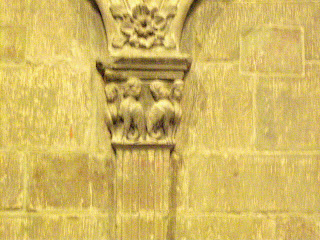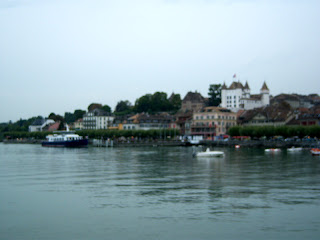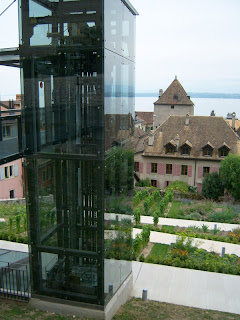Vevey. Not far from Montreux, on Lake Geneva. On the Swiss Riviera.
It deserves its accolades for surroundings. Charlie Chaplin came here to live, in 1953, with his family after being subjected to the witch hunts of the McCarthy era in the US. He was in his 60's then, see http://www.swissinfo.ch/eng/specials/Charlie_Chaplin_s_star_on_rise_again.html?siteSect=22121&sid=6712262&cKey=1251963835000&ty=st/ He died here in 1977, at age 88 or so.
 Charlie Chaplin memorial, view toward Lake Geneva, Switzerland
Charlie Chaplin memorial, view toward Lake Geneva, Switzerland
 Charlie Chaplain contemplates The Fork, Lake Geneva, Vevey, Switzerland
Charlie Chaplain contemplates The Fork, Lake Geneva, Vevey, Switzerland
Now: The fork in the lake. Apparently this commemorates the tenth anniversary of a food museum across the way: Henri Nestle started his powdered milk factory here in the 19th Century.
Lake Geneva has been settled for thousands of years, but the earliest Celtic tribes left no written records. Start, then, with the Romans in the first century BC, if you need writing. Romans, then Burgundians, then Dukes of Savoy, Reformation and Revolution. And an international role in its secret banking, alleging neutrality in order to maximize profits from that, then League of Nations and United Nations at Geneva, and the Red Cross. Switzerland in a nutshell, or bank vault.
Look at the changes in boundaries among groups claiming this area throughout history, at ://history-switzerland.geschichte-schweiz.ch/lake-geneva.html/. Many forks in those roads.
.
 Giant fork, Lake Geneva, Vevey, Switzerland. Commemorates food products museum.
Giant fork, Lake Geneva, Vevey, Switzerland. Commemorates food products museum.
Now, for romance.
What other visage is that, which now presents its solitary self to mine wandering eyne?
A romantic poet, bigger than life, also gazing soulfully out to Lake Geneva's far shores. Mihai Eminescu, 1850-1889. Ah, so young, she sighed.
 Mihai Eminescu, Romanian poet, Lake Geneva, Vevey, Switzerland
Mihai Eminescu, Romanian poet, Lake Geneva, Vevey, Switzerland
Read his poetry, aloud, standing and gesturing in front of your own mirror. Do three a day. Start at ://www.romanianvoice.com/poezii/poeti_tr/eminescu_eng.php/ Did your life improve? No? Do it again. He appreciates you. He really does. The one entitled, "Desire" however, must be whispered.
The melancholy one. I have been searching....
 Vevey, Lake Geneva, Switzerland: Mihai Eminescu, or M. Eminovici (Eminovitch)
Vevey, Lake Geneva, Switzerland: Mihai Eminescu, or M. Eminovici (Eminovitch)
.
Here is a brief biography - see ://www.muc.de/~tueting/EMINESC.HTMLhe died in Bucharest, after 5 years of paralysis. but no information is given about its origin.
There's a place for you, as well, while you read, or contemplate. Sit here, at the Lake, in a formed chair bolted to the rock against the storms.
 Chairs on the rocks, Vevey, Lake Geneva shore, Switzerland
Chairs on the rocks, Vevey, Lake Geneva shore, Switzerland
At first, they look like some form of sea bird. but have faith. Those are two little chairs just for you; and just a solitary bird beside. Just watch your step. No railings. Just clamber down.
 Chair for you, bolted to rock, Lake Geneva shore, Vevey, Switzerland
Chair for you, bolted to rock, Lake Geneva shore, Vevey, Switzerland
It deserves its accolades for surroundings. Charlie Chaplin came here to live, in 1953, with his family after being subjected to the witch hunts of the McCarthy era in the US. He was in his 60's then, see http://www.swissinfo.ch/eng/specials/Charlie_Chaplin_s_star_on_rise_again.html?siteSect=22121&sid=6712262&cKey=1251963835000&ty=st/ He died here in 1977, at age 88 or so.
 Charlie Chaplin memorial, view toward Lake Geneva, Switzerland
Charlie Chaplin memorial, view toward Lake Geneva, Switzerland- Update to 2014: The life of Charlie Chaplin is now memorialized in a new biography by Peter Ackroyd, see Financial Times review by Susie Boyt at http://www.ft.com/intl/cms/s/2/a75b66fc-b8ce-11e3-835e-00144feabdc0.html#axzz300RUM4DD A "perilous and often frightening" childhood, with "disturbances and deprivations" -- humiliations and a mother's madness fostered in the child and adult Charlie Chaplin a multitude of defenses and drive for power and control, and the uses of timing and humor in his repertoire of mannerisms, the unexpected. He once shared an apartment with Stan Laurel. Through his work, he portrayed "a life in a world that may not be worth inhabiting".
- By 1915, he was "the most famous person in the world" and at about age 25.
 Charlie Chaplain contemplates The Fork, Lake Geneva, Vevey, Switzerland
Charlie Chaplain contemplates The Fork, Lake Geneva, Vevey, SwitzerlandNow: The fork in the lake. Apparently this commemorates the tenth anniversary of a food museum across the way: Henri Nestle started his powdered milk factory here in the 19th Century.
Lake Geneva has been settled for thousands of years, but the earliest Celtic tribes left no written records. Start, then, with the Romans in the first century BC, if you need writing. Romans, then Burgundians, then Dukes of Savoy, Reformation and Revolution. And an international role in its secret banking, alleging neutrality in order to maximize profits from that, then League of Nations and United Nations at Geneva, and the Red Cross. Switzerland in a nutshell, or bank vault.
Look at the changes in boundaries among groups claiming this area throughout history, at ://history-switzerland.geschichte-schweiz.ch/lake-geneva.html/. Many forks in those roads.
.
 Giant fork, Lake Geneva, Vevey, Switzerland. Commemorates food products museum.
Giant fork, Lake Geneva, Vevey, Switzerland. Commemorates food products museum.Now, for romance.
What other visage is that, which now presents its solitary self to mine wandering eyne?
A romantic poet, bigger than life, also gazing soulfully out to Lake Geneva's far shores. Mihai Eminescu, 1850-1889. Ah, so young, she sighed.
 Mihai Eminescu, Romanian poet, Lake Geneva, Vevey, Switzerland
Mihai Eminescu, Romanian poet, Lake Geneva, Vevey, SwitzerlandRead his poetry, aloud, standing and gesturing in front of your own mirror. Do three a day. Start at ://www.romanianvoice.com/poezii/poeti_tr/eminescu_eng.php/ Did your life improve? No? Do it again. He appreciates you. He really does. The one entitled, "Desire" however, must be whispered.
The melancholy one. I have been searching....
 Vevey, Lake Geneva, Switzerland: Mihai Eminescu, or M. Eminovici (Eminovitch)
Vevey, Lake Geneva, Switzerland: Mihai Eminescu, or M. Eminovici (Eminovitch).
Here is a brief biography - see ://www.muc.de/~tueting/EMINESC.HTMLhe died in Bucharest, after 5 years of paralysis. but no information is given about its origin.
There's a place for you, as well, while you read, or contemplate. Sit here, at the Lake, in a formed chair bolted to the rock against the storms.
 Chairs on the rocks, Vevey, Lake Geneva shore, Switzerland
Chairs on the rocks, Vevey, Lake Geneva shore, SwitzerlandAt first, they look like some form of sea bird. but have faith. Those are two little chairs just for you; and just a solitary bird beside. Just watch your step. No railings. Just clamber down.
 Chair for you, bolted to rock, Lake Geneva shore, Vevey, Switzerland
Chair for you, bolted to rock, Lake Geneva shore, Vevey, Switzerland Vevey, Switzerland. Charlie Chaplin memorial
Vevey, Switzerland. Charlie Chaplin memorial Yverdon-les-Bains, Switzerland
Yverdon-les-Bains, Switzerland Heinrich Pestalozzi, 19th Century Educational Reformer, Yverdon Castle (Yverdun)
Heinrich Pestalozzi, 19th Century Educational Reformer, Yverdon Castle (Yverdun) Bern Cathedral facade, parade to doom
Bern Cathedral facade, parade to doom Detail, Judgment Day, Bern Cathedral facade, Switzerland
Detail, Judgment Day, Bern Cathedral facade, Switzerland Vegetable Tour Bus, Geneva, Switzerland
Vegetable Tour Bus, Geneva, Switzerland Pet recycling, Geneva, Hotel Hallway, Switzerland
Pet recycling, Geneva, Hotel Hallway, Switzerland St. Peter's Cathedral, Choir Stalls, Geneva CH
St. Peter's Cathedral, Choir Stalls, Geneva CH Unwilling worshiper, St. Peter's Cathedral, Geneva
Unwilling worshiper, St. Peter's Cathedral, Geneva Domestic spat, choir stall seating, with a joker in the middle, St. Peter's Cathedral, Geneva, Switzerland
Domestic spat, choir stall seating, with a joker in the middle, St. Peter's Cathedral, Geneva, Switzerland Floral and supplicant rodent, Choir Stalls, seats, St. Peter's Cathedral, Geneva
Floral and supplicant rodent, Choir Stalls, seats, St. Peter's Cathedral, Geneva Sacrificial ram, eyed suspiciously, Choir stall seating, stern person in the middle, St. Peter's Cathedral, Geneva, CH
Sacrificial ram, eyed suspiciously, Choir stall seating, stern person in the middle, St. Peter's Cathedral, Geneva, CH Exterior real people's faces, Sibenik Cathedral, Croatia
Exterior real people's faces, Sibenik Cathedral, Croatia Reformers let some beauty remain, St. Peter's Cathedral, Geneva
Reformers let some beauty remain, St. Peter's Cathedral, Geneva Stained glass, St. Peter's Cathedral, Geneva, Switzerland
Stained glass, St. Peter's Cathedral, Geneva, Switzerland Chapel Ceiling, Vaulting, Ribs, Painting, St. Peter's Cathedral, Geneva
Chapel Ceiling, Vaulting, Ribs, Painting, St. Peter's Cathedral, Geneva Fanciful capitals, St. Peter's Cathedral, Geneva
Fanciful capitals, St. Peter's Cathedral, Geneva Le Jet d'Eau - Water Fountain, Geneva, Swizerland
Le Jet d'Eau - Water Fountain, Geneva, Swizerland Reformation Wall, The Four Reformers, Bastion Park, Geneva CH
Reformation Wall, The Four Reformers, Bastion Park, Geneva CH St. Peter's Cathedral, John Calvin's Chair
St. Peter's Cathedral, John Calvin's Chair Prisoners of war, seated; sculpture, International Red Cross Red Crescent Museum, Geneva
Prisoners of war, seated; sculpture, International Red Cross Red Crescent Museum, Geneva Political prisoners, standing, sculpture, entry, International Red Cross and Red Crescent Museum, Geneva, Switzerland
Political prisoners, standing, sculpture, entry, International Red Cross and Red Crescent Museum, Geneva, Switzerland Symbols for International Red Cross and Red Crescent Museum, canopy at entry
Symbols for International Red Cross and Red Crescent Museum, canopy at entry Three-legged chair. Anti-personnel landmine symbol: UN, Geneva,Switzerland
Three-legged chair. Anti-personnel landmine symbol: UN, Geneva,Switzerland Dignitary entrance drive. United Nations, Geneva, Switzerland. Tourists around back.
Dignitary entrance drive. United Nations, Geneva, Switzerland. Tourists around back.  UN, Geneva CH, Main Conference Room.
UN, Geneva CH, Main Conference Room. Mural, European HQ, UN, Geneva CH
Mural, European HQ, UN, Geneva CH Mural, United Nations, European Headquarters, Geneva.
Mural, United Nations, European Headquarters, Geneva.  Cast bell, Japan Peace Monument, UN, Geneva, Switzerland
Cast bell, Japan Peace Monument, UN, Geneva, Switzerland Nyon, Switzerland. Water view
Nyon, Switzerland. Water view Nyon Castle - Chateau, Nyon CH
Nyon Castle - Chateau, Nyon CH The Savoys' Castle with frescoes for performing arts, Nyon, square interior
The Savoys' Castle with frescoes for performing arts, Nyon, square interior Chateau, Nyon, Switzerland
Chateau, Nyon, Switzerland Chateau, smaller one, not face-lifted and lovely, Nyon Switzerland
Chateau, smaller one, not face-lifted and lovely, Nyon Switzerland Nyon outdoor elevator, from hill Chateau to riverfront area, le Rive
Nyon outdoor elevator, from hill Chateau to riverfront area, le Rive Corinthian columns, Nyon, park area, Roman ruins, Switzerland
Corinthian columns, Nyon, park area, Roman ruins, Switzerland